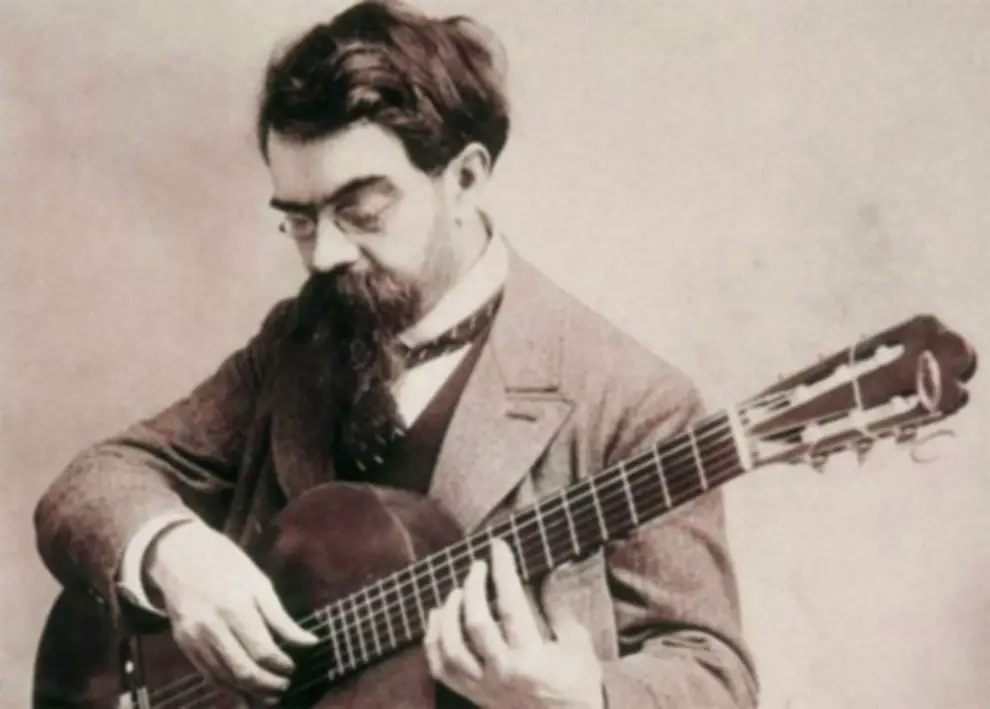Lágrima is a piece by Francisco Tárrega, and certainly a little gem in the guitar’s repertoire. It’s called “lágrima” (tear, or teardrop) because of the sadness in the second section, and isn’t a piece difficult to play: the feeling is much more important than technique with this one.
Lágrima
Composed between late 1891 and early 1892, Lágrima (teardrop), which is a romantic prelude for solo guitar, is one of Francisco Tárrega’s most performed pieces.
Lágrima is a very short piece consisting of only 16 bars., but, despite its shortness and simplicity, it still bears some technical difficulties, as usual in Tárrega’s composition.
It has an A-B-A structure, section A being in E major and B in E minor, and has been overwhelmingly highlighted by critics because of its simplicity and melancholic atmosphere. Each section has 8 bars.
- Section A consists of a very simple and predictable melody with quarter notes and dotted half notes, while the accompaniment has eighth notes.
- Section B turns a little bit less predictable but otherwise still very simple, with eighth notes on the main voice.
- At the end of section B, section A is repeated to close the work.
Francisco Tárrega

Francisco de Asís Tárrega y Eixea (21 November 1852 – 15 December 1909) was a Spanish composer and classical guitarist of the Romantic period.
As a composer Tárrega was conservative, his style was similar to the general trends in the second half of the 19th century. A virtuoso on his instrument, he was known as the “Sarasate of the guitar”.
Tárrega is considered to have laid the foundations for 20th-century classical guitar and for increasing interest in the guitar as a recital instrument. Tárrega preferred small intimate performances over the concert stage. Some believe this was because he played without the nails needed for volume. Others say this was related to his childhood trauma.
He composed 78 original scores and 120 transcriptions, mostly for his own use.
Tárrega is the composer of what has been claimed to be “probably the world’s most heard tune”: the Nokia ringtone, Nokia tune (see notes 1), also used in advertising spots, is based on Tárrega’s Gran Vals. An “Excerpt from Recuerdos de la Alhambra” was the last track of U.S. rock group The Illusion’s final album “If It’s So”. It was performed by their guitarist Richie Cerniglia. His music also inspired Mike Oldfield to arrange Tárrega’s tremolo study “Recuerdos de la Alhambra” for the soundtrack of the film The Killing Fields.
As with several of his Spanish contemporaries, such as his friend Isaac Albéniz, he had an interest in combining the prevailing Romantic trend in classical music with Spanish folk elements and transcribed several of Albéniz’s piano pieces. The noted contemporary guitarist and composer Angelo Gilardino has written that Tárrega’s 9 Preludios are “… the deepest musical thought of Tárrega in the most concentrated form.”

Related: Gran Vals – Francisco Tárrega
César Amaro

César Nicanor Amaro Carlevaro was a guitarist born in Montevideo, Uruguay, on 25 October 1948. He died on 31 July 2012. He is well known among many classical guitar players and listeners.
Cesar Amaro was an active teacher of the guitar. He was also the headmaster of the Guitar Superior Studies at the Conservatories of the towns of San José y Rocha, Uruguay. He has also attended as a jury member in several international guitar competitions.
As an active arranger and composer, he has created several works for guitar solo, two guitars, and chamber orchestra.
Notes
- The Nokia tune (also called Grande Valse on old Nokia mobile phones) is a phrase from a composition for solo guitar, Gran Vals, by the Spanish classical guitarist and composer Francisco Tárrega, written in 1902.
Sources
- Francisco Tárrega on Wikipedia
- César Amaro on Wikipedia
- Lágrima (Tárrega) on Wikipedia